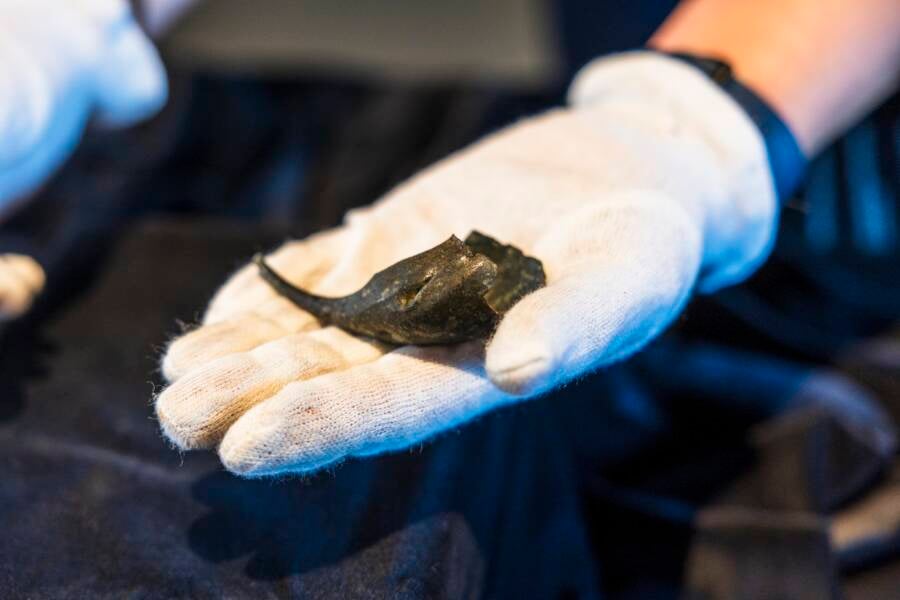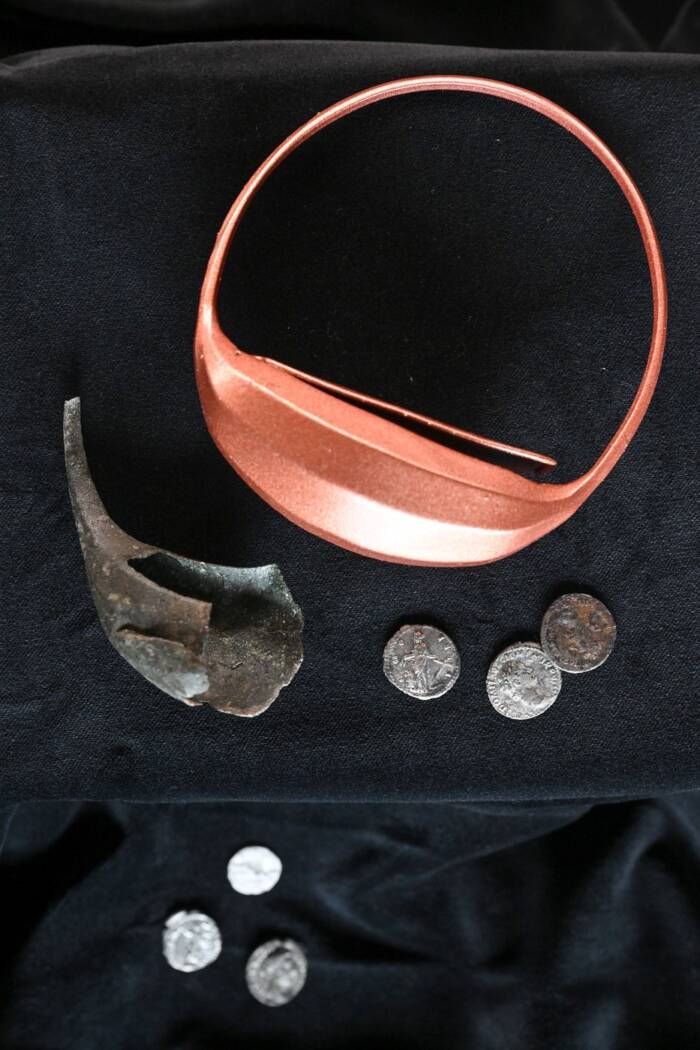Capable of holding approximately 50 silver denarii, almost a full year's pay, this purse would have been worn on the left arm in order to keep the right free for combat.

Václav Šálek, ČTKThe 1,800-year-old fragment of a Roman soldier’s wrist purse found at Hradisko Hill in the Czech Republic.
Archaeologists in the Czech Republic’s South Moravia region made a rare discovery earlier this year: an 1,800-year-old bronze wrist purse once worn by a Roman soldier, believed to be the oldest artifact of its kind ever found in the country.
The purse fragment was found in January 2025 on Hradisko Hill, where a fortified camp had been occupied by the 10th Roman Legion during the Marcomannic Wars in the late second century C.E. Although just a small fragment of the purse was found, experts instantly recognized it for what it was.
While technically a purse, this artifact does not resemble the satchel-like bags of today. Rather, it looks more like a compact money box, one that would have fit snugly around the arm. Roman soldiers often carried essential coins in these purses, allowing them to keep their valuables close without hindering their combat abilities.
Similar artifacts have been found across former Roman territories, such as Britain and Danube, but this discovery marks the first time such an object has been found in what was once enemy territory.
How Ancient Roman Soldiers’ Purses Served Practical And Strategic Purposes

Václav Šálek, ČTKThe newly-found wrist purse fragment at the bottom left, alongside coins and a replica of a full wrist purse.
Today, a purse is as much a fashion statement as it is a utilitarian object, but for Roman soldiers, this was not the case. These ancient purses — for lack of a better term — were simply meant to keep coins close to the body while freeing up the soldier’s dominant arm for combat.
“It is more like a small money box,” said Balázs Komoróczy of the Czech Academy of Sciences, speaking to Radio Prague International. “It was worn by sliding it onto the arm or forearm. The tension around the arm kept it closed and secure.”
In this particular case, the design indicates that the purse would have been worn on the left arm.

Ashmolean MuseumA similar bronze wrist purse found at Vindolanda.
No coins were found inside the purse, but nearby discoveries offered some insight into its contents. Silver Roman coins found nearby helped experts date the artifact, and it is estimated that this purse likely held around 50 denarii — a fair amount, suggesting the owner may have been a junior officer or someone handling their unit’s finances.
“Most of the coins found at the site and in the surrounding area date back to the reign of Marcus Aurelius,” Komoróczy said. “They typically feature either the emperor himself or his wife, Faustina.”

A fresco of a Roman soldier in armor. Soldiers would have worn wrist purses on their non-dominant arm to allow them to fight while keeping valuables close.
Notably, the discovery site at Hradisko Hill was once the location of a Roman military encampment during the Marcomannic Wars, Marcus Aurelius’ campaign against Germanic and Sarmatian tribes in the second century C.E. This also makes it the first such purse found outside the formal borders of the Roman Empire.
Hradisko Hill Was Occupied By The 10th Roman Legion During The Marcomannic Wars
Between 166 and 180 C.E., the Roman Empire, under Marcus Aurelius, was engaged in a series of brutal conflicts with various Germanic and Sarmatian tribes — chiefly the Marcomanni, Quadi, Iazyges, Cotini, and others — along the Danube frontier. The so-called Marcomannic Wars were initially provoked by pressures on Rome’s borders, then exacerbated by the devastation of the Antonine Plague.
As these various tribes launched raids into Roman Pannonia and parts of northern Italy, Marcus Aurelius retaliated across the Danube and suffered a notable defeat near Carnuntum. The tide eventually turned in Rome’s favor, however, leading the Roman emperor to consider founding new provinces north of the Danube, in the modern-day Czech Republic and Slovakia. He planned to name these provinces Marcomannia and Sarmatia.

Wikimedia CommonsThe death of Marcus Aurelius in 180 C.E.
Those plans changed during the second phase of the war. As Roman legions devastated the Quadi and Iazyges, deposed tribal kings, and exacted heavy terms, Marcus Aurelius met his own tragic end in 180 C.E. — of natural causes, though, and not by his son’s hand, as depicted in the popular 2000 film Gladiator.
His son Commodus soon ascended to the imperial throne — and made a controversial decision: He abruptly ended his father’s campaigns, negotiated peace with the tribes, and returned to Rome.

Wikimedia CommonsCommodus leaving the Coliseum.
But while Commodus may have secured peace in the short term, his decision ultimately contributed to subsequent instability at the frontier and within Rome, as his mismanagement deepened civil unrest and diminished faith in the imperial leadership. His generals had urged him to continue the campaign, but it was clear that the new emperor had little interest in this pursuit.
It wasn’t long before the true incompetence of the new emperor came to light. Commodus eventually descended into madness, ruling like a mad dictator driven by lust and ego, even going so far as to rename months and cities after himself. It’s little wonder why so many plotted his death, and why he is widely thought of as one of the worst Roman emperors to ever rule.
After reading about this piece of Roman history found in the Czech Republic, read about the Roman military tactic of decimation. Then, read the stories of 11 fearsome gladiators from ancient Rome.





